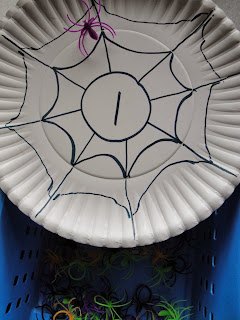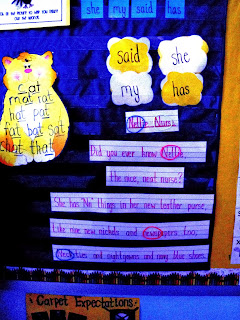We wanted to share with you a few things we loved to use teaching math, science, reading and writing units last month from each of our classrooms. We hope this will help explain a few of the terms you hear the teachers and students use (such as "buttering our popcorn words"). Please enjoy this little review of our October Units and some of our favorite teaching tools from last October.
In Ms. D's class they really got into their math centers with October inspired counting activities. This is a super cute and super easy way to make counting fun for your child. All you need are some paper plates and some spider rings. These are great to use any time of year!
Ms. D also made a quick and easy upper/lower case letter match. You can find these cute cut outs at a teacher store, at the dollar store or you can make them yourself with construction paper. The kids love it when their "work" is made into fun learning centers like this!
This idea helps the student learn one-to-one correspondence (knowing that the number symbol for 1 equals only one spider on the web and being able to do this for numbers one through ten). We will be introducing teen numbers this month so the fall and Thanksgiving themed activities will be coming out during center time!
In Ms. Boatright's class the students demonstrated their understanding of the life cycle of pumpkins by creating this super cute pumpkin, flower, leaves and seed mobile. They then decorated their classroom by hanging their science mobiles from the ceiling. Ms. Boatright's room started looking like fall harvest!
This activity helped the students develop fine motor skills by cutting and gluing the mobile pieces. They also had to problem solve how to sequence the order of the life cycle correctly. This was very meaningful after our field trip to the pumpkin patch where they got to see the life cycle of the pumpkin in the garden. The students had to follow multi-step directions, listen closely, understand vocabulary and look closely at the first letter of the words to place them with the correct picture (the seed and the word SEED, the leaves and the word LEAVES, the flower and the word FLOWER and the pumpkin and the word PUMPKIN). The students also got to cut out and create their own pumpkin recalling the different shapes pumpkins can be (oval or circle).
In Ms. Allen's class you can see how the students "butter" their popcorn words after they have learned them. They add the yellow "butter" after they have practiced the words and found them in books and in their daily poetry which she places on sentence strips and places in the pocket chart. The students use Wiki Stiks to find the popcorn word(s) of the week in the poem. The students also started learning about word families in October. You can see her "AT" family cat with the "AT" family words! Ms. Allen has word family pictures for all of the word families the students will learn in kindergarten and they are placed around the classroom for the students to use during reading and writing workshop.
Ms. Allen also created this wonderful anchor chart for the students to support their learning in Writing Workshop. "When you think you are done you have just begun" is something all of the teachers say when the students say they are finished with a book they are writing. When they are writing at home refer to this chart and ask them the following questions: can you add more pictures/details to your book?, can you add words to your book? (really a great way to practice popcorn words and to start sounding out words), OR if they are really done and have added details and words (if they can) ask them if they are ready to start a new book.
In Mrs. O's class they students spent October learning about their new reading super powers (this unit was taught in all of the Kindergarten classes). Mrs. O made this super cool reading anchor chart showing the students how to use their new super reading powers. They can think about the story, use their Eagle Eye to look at the pictures to figure out a tricky word, they can take a picture walk to think about what they story is about and try to think about words they can expect to see in the text, AND they can use their super reading finger to tap under each word one time to stay in place and on track in the text. I bet you didn't know she was such a great artist!
This is Mrs. O's word wall. Each classroom has one. You can see that Mrs. O has added all of the popcorn words her students have learned so far this year. She also has all of the color words they have learned up there. The students are learning how to use the word wall during writing workshop to help them write pattern books. The word wall will keep getting fuller and fuller as the students learn more and more words this year!
In Ms. Arrendale's class the students finally were able to explore the fall items brought back from the pumpkin patch field trip during their science time. They were able to compare and contrast these fall fruits/vegetables to the pumpkin they carved. They were able to estimate the number of seeds and graph fall items during math.
The students were taught how to use a magnifying glass to observe and study the inside of the pumpkins and other fruit/vegetables. The children were encouraged to use descriptive words to explain what they were observing. They also created an anchor chart using descriptive words to describe a pumpkin after they used the magnifying glass to study the pumpkin closely.
In Ms. Arrendale's class they students drew different types of Jack-O-Lantern faces using the basic shapes on write-on/wipe-off boards and voted on the face they wanted carved into the pumpkin. This was the finished product using squares, semi-circles, triangles, ovals and rectangles. The students also wrote about their trip to the pumpkin patch in writing workshop.
We hope this little glimpse into our daily classroom activities helps you facilitate conversations that will help reinforce skills they were exposed to during last months lessons. We had a great time teaching all of our kindergarten kids last month! Fall is a great time to expand on their math, language and science skills. We will update you each month with a monthly classroom update post to keep you informed. Now that you know how to "butter" your popcorn words get a yellow highlighter and have your child "butter" some popcorn words in magazines, newspapers and junk mail you receive at home. It is a fun and meaningful way to practice those popcorn words!































